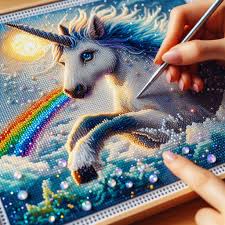Mastering the Art of Painting a Realistic Diamond
Painting a realistic diamond challenges even the most skilled artists, but mastering this skill can elevate your artwork to new levels of realism and brilliance. Capturing the complex interplay of light and reflection in a diamond requires precision and understanding of light physics and gemology.
Understand Diamond Anatomy
Before you dip your brush, understand a diamond’s anatomy. A diamond's brilliance largely comes from its cut, which comprises numerous facets. These facets must be portrayed accurately to reflect and refract light as a real diamond would. Typical round brilliant diamonds have 57 or 58 facets. An accurate depiction requires you to recognize and replicate these planes in your painting.
Choose the Right Materials
Selecting the right canvas and paints is crucial. A smooth, fine-grained canvas is ideal as it allows for detailed work necessary for depicting the fine facets of a diamond. Acrylic paints are preferred for their brilliance and quick drying times, but for more depth and subtlety, oil paints excel. They blend beautifully and provide the luminosity needed to mimic a diamond's sparkle.
Setting Up Your Workspace
Proper lighting is non-negotiable. Diamonds sparkle because of light, so simulate a strong, direct light source to create realistic reflections and shadows in your painting. Position your canvas so the light hits it similarly to how light would strike a real diamond. This setup will guide you on where the highlights and shadows fall, which are critical for realism.
Sketch and Shade
Begin by sketching the outline of the diamond with a very light graphite pencil. Use geometric precision to outline each facet. Once your basic outline is in place, start shading. Shades should vary sharply between facets depending on their orientation relative to the light source. Use white for the brightest highlights and a mix of gray and slight blue for shadows to suggest depth.
Adding Sparkle and Brilliance
This is where your skill really shines. Adding the sparkle in a diamond involves detailed, delicate brushwork. Use a fine brush to gently apply the brightest whites to the areas where light is most concentrated. These should be very small, intense spots of white, concentrated on the upper facets of the diamond.
The Final Touch: Glazing for Extra Gloss
Once the acrylic or oil paints have dried, consider applying a glaze to enhance the diamond’s shine. This layer not only protects your painting but also adds an extra layer of depth and gloss that mimics a diamond's natural luster.
For those seeking a detailed guide on this subject, exploring a painting of a diamond can provide additional insights and techniques that can be applied in your artistic endeavors.
Dive In and Experiment
Painting a realistic diamond takes practice and patience. Don’t be discouraged by initial attempts. Each stroke teaches something new about light and shadow. Over time, your ability to render the complex beauty of a diamond will only improve.
In essence, creating a realistic diamond on canvas is about understanding light, precision in replication, and patience in execution. This challenge not only improves your painting skills but also adds a stunning element to your artistic portfolio. Embrace the challenge, and let your canvas shine bright like a diamond.

